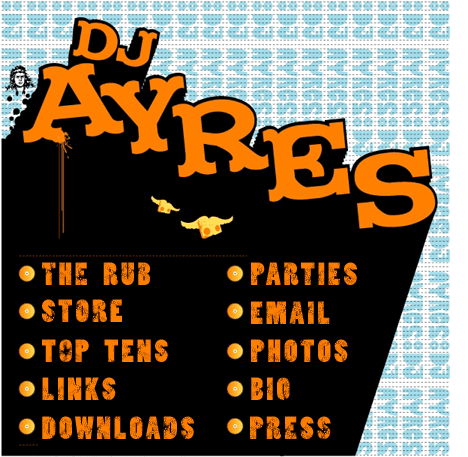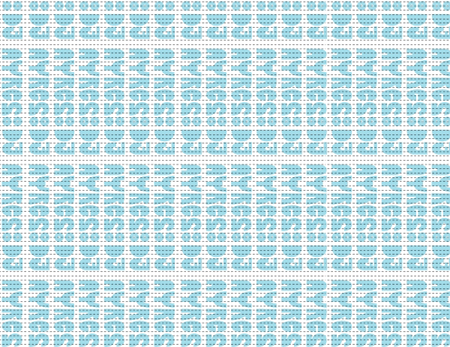














The Fader Magazine #36
Vinyl Archaeology Column
First Wave Freestyle
Written by DJ Ayres
![]() CLICK
TO DOWNLOAD DJ AYRES'S FREESTYLE MIX
CLICK
TO DOWNLOAD DJ AYRES'S FREESTYLE MIX
Sure there’s geek appeal to poindextering out to obscure records,
but when it's time to party, those sealed Axelrods ain't gonna cut it.
(Unless you party with morphine, but that’s a different story.)
Since every ’80s pop record been worn out already, it’s time
to channel your inner 15 year-old Puerto Rican girl with some freestyle.
Freestyle was crossover music, combining the electro hip-hop jam and the
pop ballad to create a new style that was equally comfortable in metropolitan
dance clubs as on the Billboard Top 10. Early ’80s tracks "Planet
Rock" from Afrika Bambaataa, "Let the Music Play" by Shannon
and Freeez’s "IOU" were the pre-style hits that jump-started
the movement, freestyle just added big hair, unrequited love and a cheese
factor turned up to 11. Its producers kept the space synths and the drum
machines of electro, but replaced the raps and computerized voices with
mostly young, untrained (predominantly female) singers. If electro was
about the future, then freestyle was about romance. Freestyle’s
reign at the top receded at the end of the ’80s, but its influence
is still felt in new electro pop like Ciara’s “1, 2 Step”
and Brooke Valentine’s “Boogie Oogie.” To this day,
new and classic freestyle is played on the dance radio stations in New
York, New Jersey and Miami, but this will focus on hits from the first
wave that lasted from 1985 to 1987.

Lisa Lisa & Cult Jam With Full Force
Lisa Lisa & Cult Jam With Full Force (CBS 1985)
With "I Wonder If I Take You Home" in 1985, Lisa Lisa became
the first real "Latin hip-hop" star, even if she was a singer
(albeit an excellent one and a total fox). Up until that point, most of
the Latino DJs in New York were playing records by black hip-hop and pop
artists, but Lisa Lisa was a Puerto Rican from Brooklyn that they could
embrace as their own. Like Jellybean Benitez did on earlier electro jumpoff
"The Mexican", the Cult Jam would sample Lisa Lisa's voice and
retrigger phrases, pitching her up and down the keyboard—a often
obnoxious technique that became a trademark for freestyle productions
and edits.

Exposé
“Point Of No Return” 12-Inch (Arista 1985)
After Lisa Lisa hit it big in the Latin club scene, producers in New York
and Miami were scouring the streets for young talent to record their lyrics
and make them some money. Miami producer Lewis A Martineé found
three singers and turned them into Exposé, who would go on to become
the genre’s biggest group. A crucial trick to making a hot freestyle
record was a keyboard melody so simple that the first time you heard it,
it sounded like the hundredth. The salsa-inflected xylophone synth on
"Point Of No Return" is catchy as fuck, but I can't cosign on
the vomitous guitar solo before the final verse.

TKA
“Scars Of Love” 12-Inch (Tommy Boy 1987)
Like Exposé, TKA was a manufactured group, but this time it was
three male teenagers from the Bronx. They were discovered by Joey Gardner,
an A&R rep from Tommy Boy Records, who convinced them to stop rapping
and focus on singing. He became their manager and put them in the studio
with the Latin Rascals, who were big radio DJs and freestyle/house edit
kings at the time. TKA were soft like one-day-old shit (they wore turtlenecks
and sung about their feelings), and young girls went batshit for "Scars
Of Love.” TKA’s tacky emo sound anticipated pop boy bands
like New Kids On The Block and when you turn on the radio in Long Island
or on the Jersey shore today, you still hear music that sounds exactly
like this.

The Cover Girls
Show Me (Fever 1987)
The Cover Girls were another party-in-a-cereal-box prefab group out of
New York, but like TKA, the Cover Girls stood out from a lot of cookie
cutter groups thanks to the Latin Rascals, whose drum programming and
vocal edits stay sharp without going overboard. Both Cover Girls tracks
"Show Me" and "Because of You" were big cotton candy
hits that recall Gloria Estefan And Miami Sound Machine with their full
pop arrangements—big synthesized horns and electric pianos that
provide a warmth not always associated with freestyle records.

Connie
“Funky Little Beat” 12-Inch (Sunnyview 1985)
Producer Amos Larkins brought the bass that made Miami famous, sustaining
the 808 kick to make it rumble. His track for "Funky Little Beat"
combines that distinctive Miami 808 sequencing with fake synth flutes
and strings, letting the sub-bass stand in for a bassline. The result
uniquely mixes a harder almost Detroit sound with the cuteness of freestyle.
(Larkins was no stranger to innovation, having already produced what many
would say is the first Miami Bass record, MC ADE's "Bass Rock Express".)
The singer Connie came from a mixed Cuban and Ecuadorian heritage, and
her career basically ended after this hit.

Stacey Q
“Two Of Hearts” 12-Inch (On the Spot 1986)
Stacey Q was the Janis Joplin of freestyle, but with more crimping. She
was almost 30 when her big hit dropped, but looked like a cracked-out
teenager. If you grew up in the ’80s you may have caught DJ Tanner’s
favorite singer performing "Two Of Hearts" on Full House. The
track’s tempo is particularly fast for freestyle, and the drums
and bassline sound an awful lot like New Order's "Blue Monday,"
but the bongo breakdown is focused. In true time capsule fashion, listed
on the picture sleeve are local party crews (the freestyle version of
the dancing gangs from Westside Story) including Thee Laydees, Unique
Playboyz and Lustik Illusions who wrote in to the Stacy Q fan club to
get shoutouts on the back cover.

Noel
“Silent Morning (“Little" Louie Vega remix)” 12-inch
(4th & Broadway 1987)
As a teenager, soon-to-be house legend Lil' Louie Vega was a freestyle
DJ, packing them in at the Devil's Nest, one of the first all-freestyle
Latin clubs in the Bronx, and later at Heartthrobs in midtown Manhattan
with his future partner in Masters At Work, Kenny Dope. His remix of Noel’s
"Silent Morning" has that slightly-choppy-breakbeat-hip-hop-meets-house-Todd-Terry
feel that was popping in the clubs at the time with tracks like “Bango”
and “Can You Party”. Just beware of the completely overboard
keymapped vocal samples. I feel bad for Noel when listening to "Silent
Morning", not only because he woke up to discover his girl left him,
but also because he was a pretty bad singer.

Taylor Dane
Tell it To My Heart (Arista 1987)
Freestyle DJs mixed in plenty of house, pop, electro and uptempo hip-hop
in their sets, and Taylor Dayne’s "Tell It To My Heart"
was a pop record with a freestyle beat that did it real big in the Latin
clubs. She came out of nowhere and with her first record crossed over
to go double platinum. On record you would swear she was black, but then
you saw her on Friday Night Videos and she was a whitey! Dayne’s
success helped enable the meganess of teen dreams Debbie Gibson and Tiffany,
who got it popping with their watered down take on freestyle. And Ric
Wake, the dude that produced "Tell it to My Heart", now works
with Mariah Carey and Jessica Simpson. That’s major.
all material © djayres.com 2005